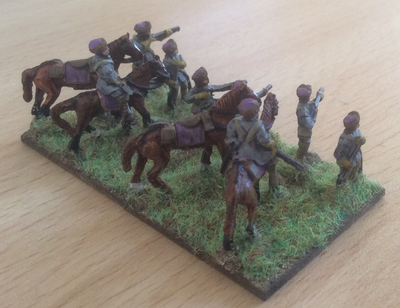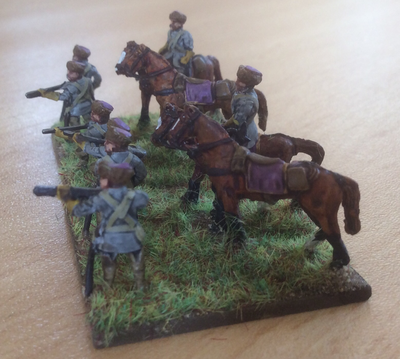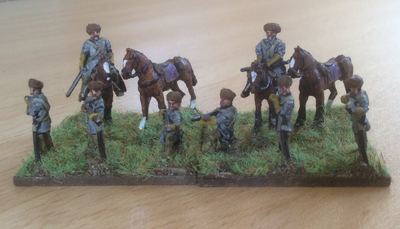|
I have just finished a new unit of Polish 17th century dragoons from the Wargamer's Fire and Sword line. I am quite pleased but the dismounted poses are almost like old flats. I guess they must be older sculpts as they are much less animated than other Wargamer figures I know. Still, it's good to have another régiment in the line. Finishing the dragoons has got me looking at the 1660 campaign again. I am working up a scenario for the battle of Słobodyszcze (Polish spelling), between a Cossack army and a smaller Polish attacker. I plan to play it with the Tercios rules by el Kraken, but as few people seem to have discovered these yet, I will try to make the scenario adaptable to any rules. This battle gives the chance to pit winged hussars and Pancerni against defended wagons and Zaporozhian foot. Despite the spin put on the outcome in the Polish commander's memoirs, it was a tactical repulse for the Poles, albeit leading to a strategic success in the end. As so little is available in English about the battle, I have written a longer background note than usual, relying on a study by Lukasz Ossolinski. I have included it below. I find it fascinating that the battle is the cause of controversy even today, with Russian, Ukrainian and Polish historians all looking at it through the prism of today's murky politics. The Battle of Słobodyszcze
1660 saw one of the most eventful campaigning seasons in the 13 Years war between the Polish-Lithuanian Commonwealth and Muscovy. Muscovite armies were active in both Lithuania and Ukraine, taking maximum advantage of the Commonwealth's weakened condition after the years of Swedish devastation of Polish-Lithuanian lands known as the 'Deluge'. In Ukraine,Voivod Sheremetyev led a combined Muscovite-Cossack army against the army of Grand Hetman Stanisław 'Rewera' Potocki. His objective, in cooperation with the Cossack army of Yuriy Khmelnytsky, was to defeat Potocki, take Lvov and perhaps threaten Kraków. Khmelnytsky's army was slow to muster and risked delaying the start of the campaign. Anxious not to lose time, Sheremetyev set his army in motion, having secured Khmelnytsky's promise to join him in the field. First contact with Potocki took place at Lubar on 14 September. Sheremetyev quickly discovered that his enemy outnumbered him by around 40,000 to 31,000. Potocki had been reinforced by the army of Field Hetman Lubomirski, fresh from campaigning on the Baltic. After a sharp engagement in which Potocki had the upper hand, Sheremetyev decided he could not win an open battle without reinforcement. He withdrew into fortified camp, first at Lubar and subsequently at Chudnov, intending to wait for Khmelnytsky to arrive and catch the enemy between their two armies. Potocki meanwhile laid siege to the Muscovite camp, placing his own fortified camp to the South of the Muscovite position. On 5 October, news reached Potocki that Khmelnytsky's 20,000 strong army was approaching from the South East and had reached Słobodyszcze, 27km from Chudnov. Potocki now faced the prospect of being caught between two enemy armies that would outnumber him by 50,000 to 40,000. Potocki and Lubomirski reacted to this threat by splitting their forces. On 6 October Lubomirski set off for Słobodyszcze with a cavalry-heavy force of around 14,000. Meanwhile, Potocki shifted the main camp to a stronger position to the West of its original location and prepared to confront a Muscovite breakout attempt. Lubomirski reached Słobodyszcze around midday on 7 October, to find the Cossacks encamped on a hill on the far side of the river Hnilopat. The Cossacks had not fortified their camp and scrambled to form a defensive position, forming a hasty barrier of wagons facing the Commonwealth advance. Cossack infantry in a fortified position was famously tough to dislodge, especially by a force lacking a strong infantry contingent of its own. Lubomirski therefore decided to attack almost directly from the line of march. After forcing the river Hnilopat, Lubomirski divided his army into three groups. The centre and left attacked the Cossack position from the south, while the right worked its way round to the east of the enemy camp. The centre and left broke into the camp, reaching as far as Khmelnytsky's own tent but losing cohesion in the process. At this point a Cossack counterattack bundled them out again and back down the hill towards the river. Only now did the attack by the right wing go in and was soundly repulsed. Lubomirski mounted another attack from the South but could not match the initial success. He withdrew across the Hnilopat at nightfall. On 8 October Lubomirski was recalled to Chudnov by Potocki, who was facing a breakout attempt by Sheremetyev. Lubomirski left his Tatar contingent to patrol the river and rejoined the main army. Khmelnytsky did not pursue. Within days, Khmelnytsky and Potocki agreed a truce; the Cossack contingent within Sheremetyev's main army began to drift away and the campaign would end with the most decisive Muscovite defeat of the war. Politics and rumours There are various theories to explain Khmelnytsky's actions in the 1660 campaign. He was a young, militarily inexperienced leader who had difficulty controlling his senior colonels. One view is that although his initial intention was to join Sheremetyev, he lost his nerve after Słobodyszcze and asked for peace. Another is that he, or more likely some of his colonels, were disenchanted with the Muscovite alliance and planned to see how the confrontation between Sheremetyev and Potocki played out before committing to one side or the other. A still harsher theory is that negotiations with Potocki were already far advanced and that Lubomirski's attack was intended to convince the last of the pro-Muscovite faction in the Cossack army to give up. Finally, some historians even claim the battle did not take place at all: they suggest it was a fig leaf invented to hide Khmelnytsky's betrayal of his Muscovite allies. This last version is hard to credit, given that correspondence survived from different participants, including foreign officers who took part in the battle. Also, if Khmelnytsky had been looking for a convincing reason why he changed sides, he and Lubomirski would presumably have spread the story that he had been defeated. On the Commonwealth side, Lubomirski's actions too have been much discussed. After his return to Chudnov, the Tatar contingent successfully kept Khmelnytsky on the far side of the Hnilopat. If he knew that Khmelnytsky was already in negotiations with Potocki, did Lubomirski need to mount his attack at all? One explanation offered to explain his aggression is that he was chafing under Potocki's command and wanted a slice of glory for himself. Whatever the whys and wherefores, Słobodyszcze provides an interesting basis for a wargame, and the chance to practice some appallingly different pronunciation!
0 Comments
Leave a Reply. |
Archives
November 2023
Categories
All
|



 RSS Feed
RSS Feed